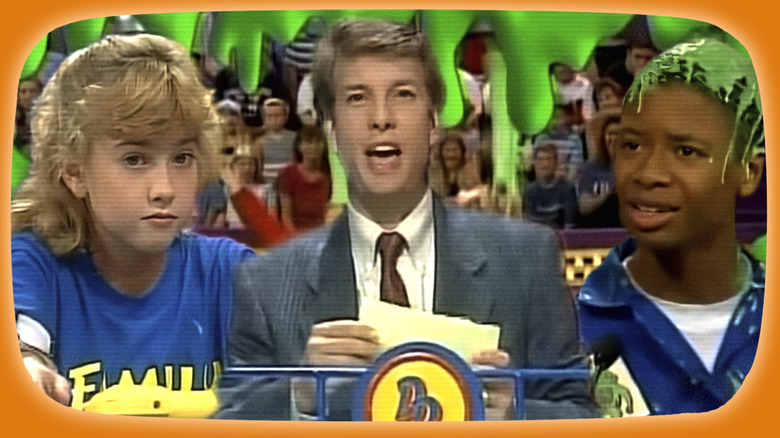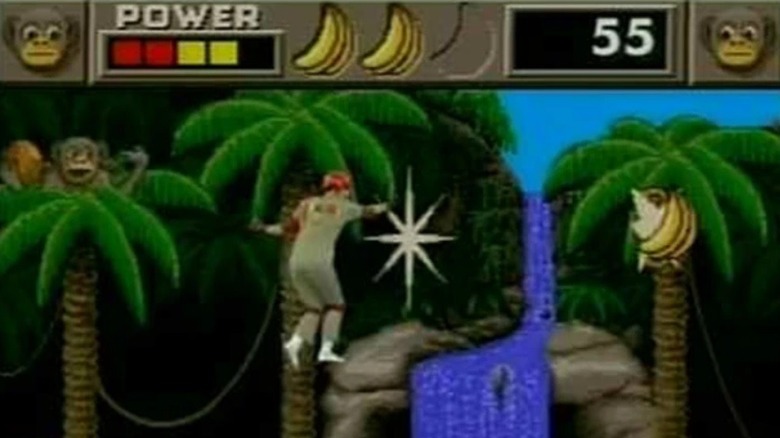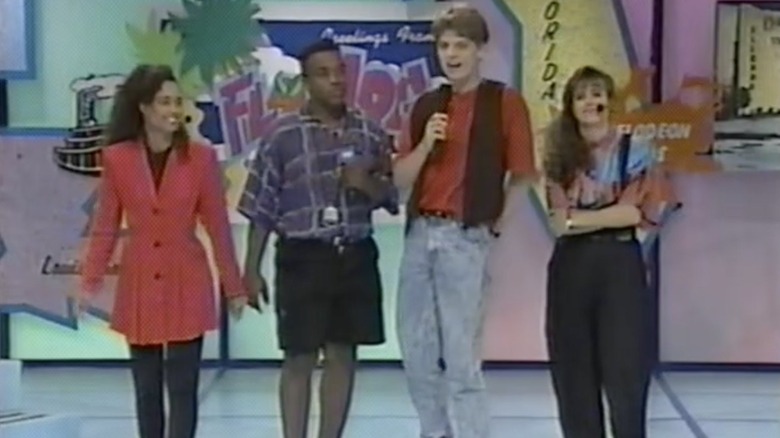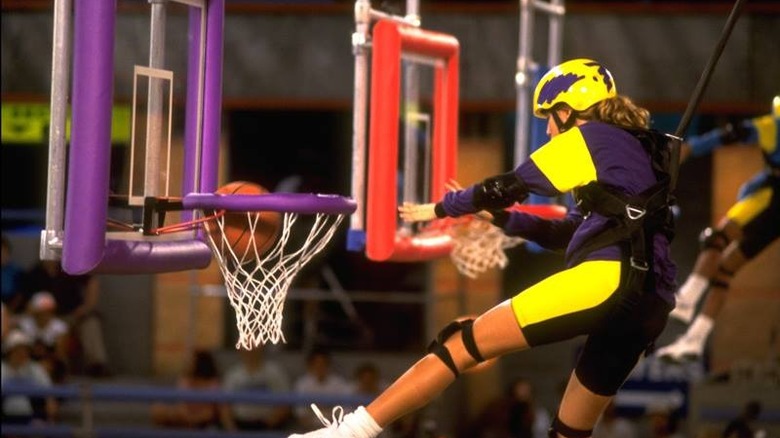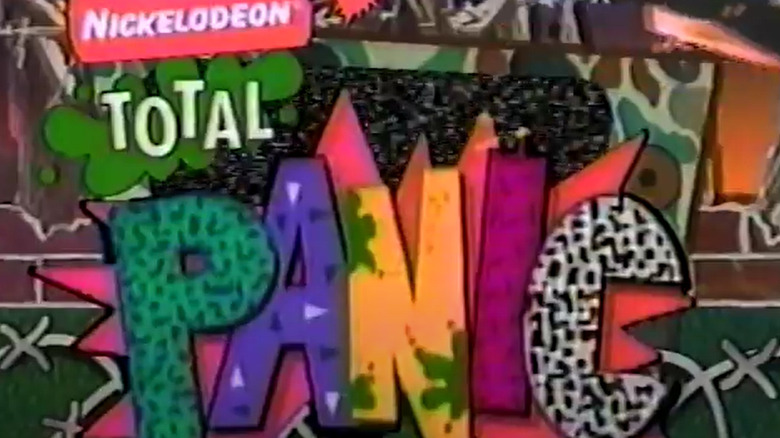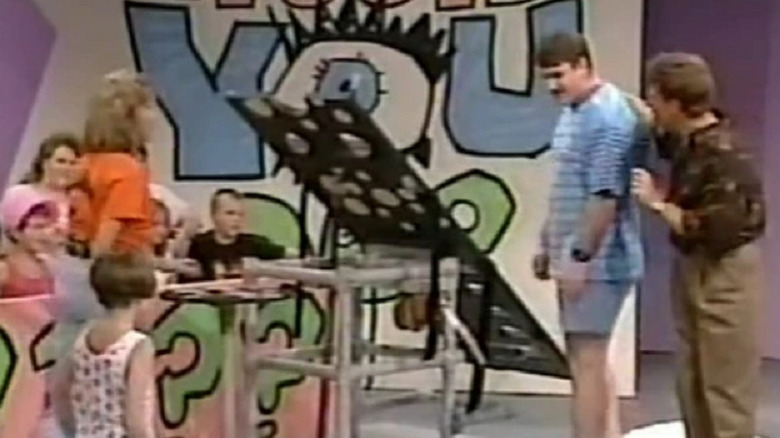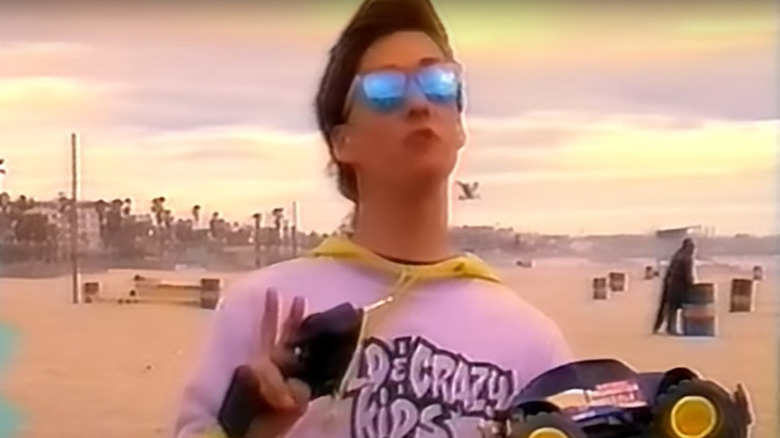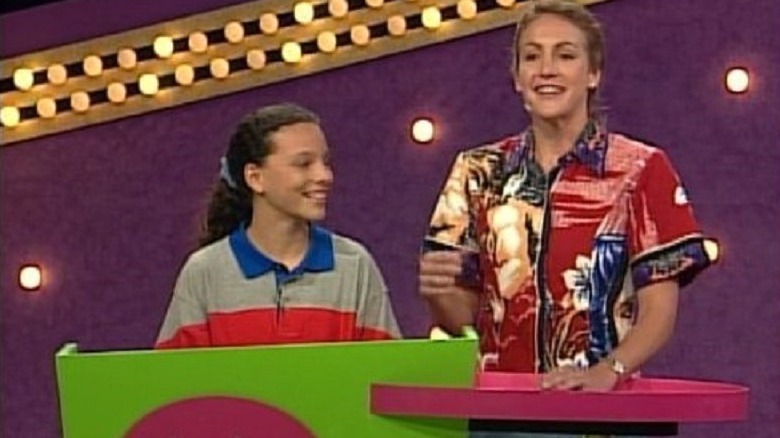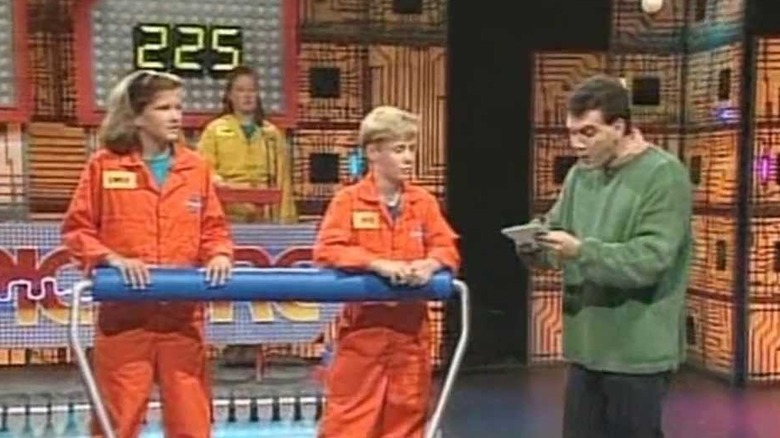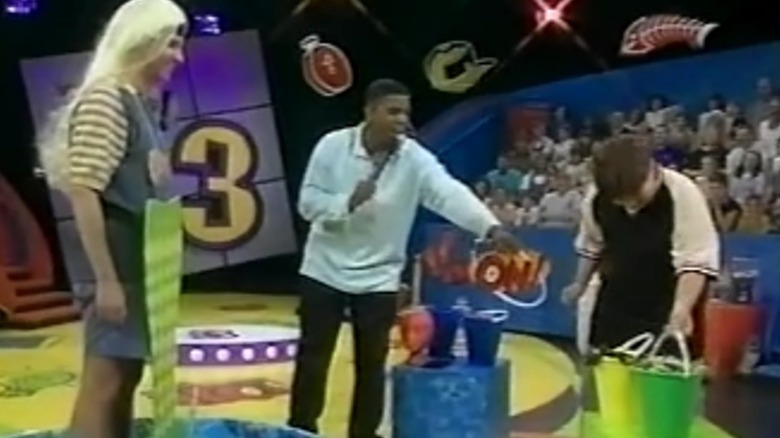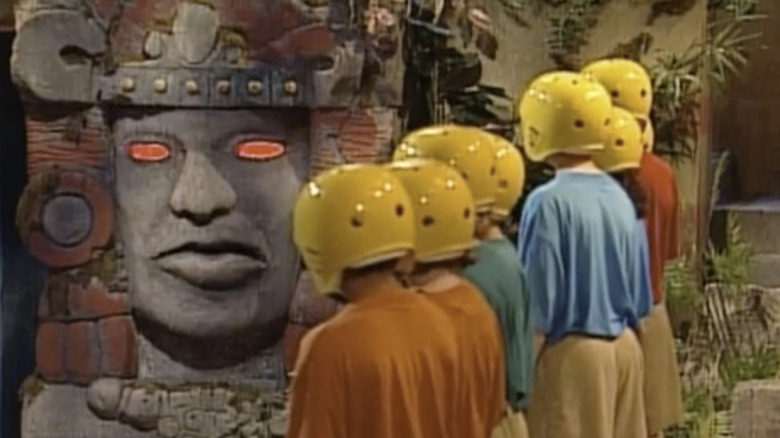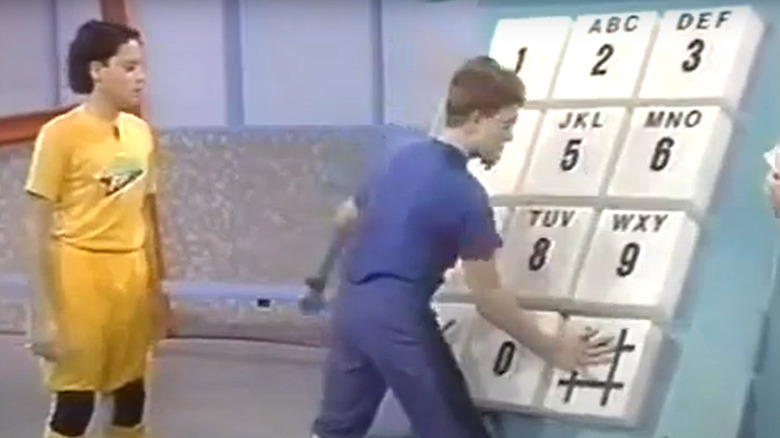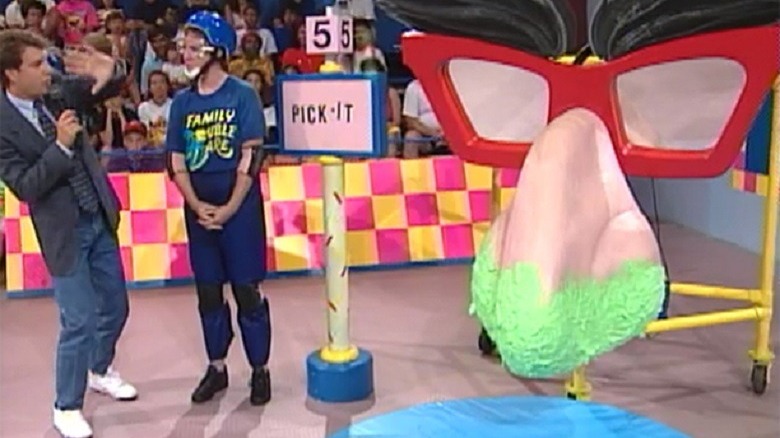'90s Nickelodeon Game Shows We Couldn't Help But Love
One of the first original shows on Nickelodeon was "Double Dare," which not only helped to put the fledgling cable channel on the map but also set an early precedent for the long-standing tradition of fun game shows aimed at kids. The game show genre had previously been largely designed for adults and featuring adult contestants, generally consisting of people just sitting in chairs as they answered questions or solved puzzles. Nickelodeon put a new twist on game shows where the kids were both the target demographic and the contestants; competitions got sillier, messier, and a lot more physical.
While Nickelodeon continues to have game shows to this day, the golden era for the genre on the network was definitely the '90s. That's when the company was still trying all kinds of wild and crazy ideas to see what worked and what didn't. Even when a concept might not have fully panned out the way it was intended to, it was typically still an entertaining misfire that occasionally pioneered elements that future shows would use more successfully.
Nickelodeon Arcade
Video game-related content is huge these days, from YouTube to Twitch and beyond. But traditional television struggled for literally decades to figure out how to build shows around video games and gaming culture, with nothing ever really sticking. Among the earliest attempts to represent video games on television was "Starcade!," which ran for just two years in the early '80s and featured kids answering trivia questions about video games before actually playing games in subsequent rounds.
This format was loosely borrowed for the innovative game show "Nickelodeon Arcade," which aired for two seasons. Like "Starcade!," kids answered questions and solved puzzles about video games, but the game-playing portions were much more ambitious. Contestants would start each episode by competing in a video game that was built from the ground up specifically for the show, though most of the games were just variations on "Pong." The main event of the show, though, was when kids got to "enter" a video game in the final round.
Of course, a lot of this took place in 1992, so the tech was pretty primitive and basically just kids running around in front of green screens. Still, it was a neat trick that looked cool for the audience at home, and really set "Nick Arcade" apart from its peers.
Outta Here!
Nick's '90s game shows involved a lot of experimentation and playing with the format of the genre. Case in point: "Outta Here!" which aired its single season between 1990 and 1991 and was a hybrid talk show, game show, and variety show. For the game show portion, kids were picked from the audience to be contestants and were then divided into two teams, each being captained by one of the show's four hosts – Mike Daniels, Tiffany Hunter, Kareen Germain, and Bruce Klassen. They would then face off in challenges that involved both answering trivia questions and competing in physical events.
But rather than just be a straight-up game show, "Outta Here!" also included segments where the hosts discussed pop culture and would even occasionally interview celebrity guests. Truth be told, it was a lot to cram into a 30-minute show, but if anyone has the mental energy to keep up with such a fast-moving and loaded-to-the-gills show, it's kids. Like most Nick game shows of the era, "Outta Here!" was filmed at the now-closed Nickelodeon Studios, which meant that any kids who happened to be visiting Universal Studios Florida on a day the show was taping had the potential to be contestants.
Guts
"Double Dare" laid the groundwork for future Nick game shows to require a lot of physicality, but none had kids sweating harder than "Nickelodeon Guts" (generally referred to as simply "Guts"). Both the title and the tagline — "Do you have it?" – made it pretty clear that a lot of athleticism was going to be required of the show's contestants, and the vibe played heavily into the increasingly prevalent "extreme" nature of pop culture marketing towards kids at the time of the show's 1992-1995 run.
Hosted by Mike O'Malley of eventual "Snowpiercer" fame, the events on "Guts" were grounded in traditional sports like basketball, football, and soccer, but things were appropriately amped up. Trampolines, harnesses, and other equipment had the contestants bouncing, flying, and otherwise careening all over the arena to ensure that goals as basic as putting basketballs into hoop were visually over-the-top and excessively difficult. Things culminated in the final round, which had players scale a vertical obstacle course called the Aggro Crag – and later, the Mega Crag and the Super Aggro Crag – with the winner getting to take home a "piece" of the fake mountain.
On top of the three seasons of the original show, there was a one-off "All-Stars" special in 1993, a Season 4 called "Global Guts" featuring players from other countries, and a 2008 revival called "My Family's Got Guts" which ran for 22 episodes.
Total Panic
Speaking of experimenting with the format, "Total Panic" – which started in 1989 but ran through 1990 – was a show that seemed to be making up its own rules as it went along with a wide variety of recurring and rotating segments. At a run time of between two and three hours per weekly Sunday morning episode, "Total Panic" was technically more of a programming block than it was a traditional show, which was common among a lot of fellow upstart cable channels like MTV that were still figuring it all out in the early days of cable.
Truth be told, most of "Total Panic" wasn't a game show at all. Much of any given episode was devoted to things like celebrity interviews, film and video game reviews, animated shorts, music videos, and footage of correspondents visiting locations and covering events. But it's worth discussing among the network's other game shows for three reasons: It did, in fact, frequently feature physical games and challenges that audience members competing in for prizes; the previously mentioned "Outta Here!" was basically a more polished and condensed version of "Total Panic" with a bigger focus on the games, and it had an interactive video-based game called "Eat-a-Bug" that was played in much the same way as the final round of "Nick Arcade" – essentially serving as the testing ground for the tech that was more extensively put to use in the later show.
What Would You Do?
Not to be confused with the long-running ABC program of the same name where hidden cameras test the moral fortitude of unsuspecting bystanders, Nick's 1991-93 show "What Would You Do?" had contestants guessing the outcome of videos depicting a variety of goofy scenarios. The footage is stopped just before its conclusion, at which point the audience has to vote on typically one of two questions — how they think the video ends, or how they themselves would have handled the situation depicted in the video.
Like a lot of early Nick shows, that video portion is essentially just a unique twist added to what was otherwise just another variation on "Double Dare" where audience members have to perform stunts or compete in physical games of the funny and-slash-or sloppy variety. The fact that Marc Summers happened to be the host of both shows only further added to the feeling that "What Would You Do?" was something of a "Double Dare" spin-off or sequel show, only with a much bigger focus on throwing, sliding in, or otherwise making messes with pies. Even so, it was an entertaining watch, resonating almost like a hybrid of "Double Dare" and "America's Funniest Home Videos."
Wild & Crazy Kids
As great as it was that so many Nick game shows forced kids to get some exercise, hardly any of them forced kids to also get out and get some fresh air. That's where "Wild & Crazy Kids" came in; it was a physical competition-based show that featured outdoor events rather than taking place entirely within a studio. Co-hosted by actor Omar Gooding of "Hangin' with Mr. Cooper" fame, "Wild & Crazy Kids" ran from 1990 to 1992 plus a revival in 2002.
In the original series, the most common type of event saw a regular sport given some sort of unique spin. For instance, a home run derby was made more difficult by contestants required to spin around and get dizzy before competing, or basketball was played on the backs of actual donkeys. The show also featured the contestants competing in classic playground games like red light-green light and tug of war. Of course, this being a Nick show 'n all, there were also token "messy" events that included variations on food fights or involved the use of slime.
While the contestants were primarily just regular kids, "Wild & Crazy" did occasionally have celebrity-themed episodes that saw cast members of contemporary shows like "Saved by the Bell," "Roseanne," and "Home Improvement" playing for various charities.
Figure It Out
After the initial thrust of physical challenge- and messy stunt-focused game shows during the first half of the '90s, Nick began to introduce more game shows in the latter part of the decade that relied more on brains. One such example was "Figure it Out," a panel-based show centered on contestants answering questions to figure out the secret talents of their fellow players. Airing from 1997 to '98, it was a kid-centric twist on a classic format previously used for such shows as "To Tell the Truth" and "What's My Line?"
That being said, "Figure it Out" didn't completely abandon that trademark Nick game show grossness. There was still the potential for players to get slimed when they unknowingly performed the "secret slime action" — typically a common action like scratching their nose or saying a basic phrase. Someone getting slimed was essentially a foregone conclusion on "Figure it Out."
"Figure it Out" remained largely unchanged for its first two seasons but added some novelty for Season 3 and 4. Season 3 was subtitled "Family Style" and featured contestants who were family members of some kind, while Season 4, subtitled "Wild Style," was all about animal-related talents plus associated costumes and wigs. "Figure it Out" came back in its more classic format for two revival seasons in 2012 and 2013.
Get the Picture
In one of the lowest-key game shows Nick ever produced, 1991's "Get the Picture" – another Mike O'Malley-hosted show — sees two teams gradually revealing a picture obscured by a video wall divided up into smaller sections. As they answer questions and complete tasks, contestants reveal the picture section by section.
While there is nothing gross or messy in "Get the Picture," Season 1 had a round comprised of physical challenges like ring toss and mini golf. Interestingly, this aspect was abandoned for Season 2. The show also switched to tallying points instead of dollar amounts. Season 2 would be the last season, though "Get the Picture" ended its run with a respectable 115 total episodes and continued to stay in regular rerun rotation for two years after its cancellation.
The show also had two international versions — one for the U.K. and another for the Netherlands called "Snap Het" (which translates to "get it").
You're On!
"You're On!" — another late-decade entry that aired in 1998, felt like a throwback to classic hidden camera shows like "Candid Camera." In retrospect, it feels more like a predictor of the prank videos that would become huge in the internet era and via shows like "Impractical Jokers." The premise was that kids would have to get random bystanders they encountered out on the street to do ridiculous things, later revealing that they were secretly being recorded while doing so.
For the show's second round, the action moved to the studio where audience members had to predict how many tasks on a given list the contestants would be able to successfully perform. It behooved the contestants to ensure that their team won, lest they be faced with punishment at the end of the episode – typically something messy like a slimming, as you may have guessed.
Though, in a fun twist, adult contestants were often slimed by their child teammates, giving the whole endeavor an element of kids getting revenge on adults that every generation of children since the beginning of time have taken great pleasure in imagining.
Legends of the Hidden Temple
Arguably the most fondly remembered game show in Nickelodeon history that doesn't involve fetching flags out of a giant boogery nose, "Legends of the Hidden Temple" was an incredibly inventive take on the genre. Leaning heavily into the show's imagined lore – up to and including a host who's a giant, talking stone head with glowing red eyes named Olmec — "Legends of the Hidden Temple" was otherwise a fairly straightforward physical challenge-based game.
However, instead of participating in versions of sports, the contestants had to do more adventure-oriented tasks like crossing rope bridges and swinging on vines. The climax of the show, and everyone's favorite part, was the very "Goonies"-esque Temple Run. In it, players had to maneuver through a maze-like structure that had dead ends, secret doors, and even temple guards to contend with as they sought out keys and, ultimately, a secret artifact in order to claim victory.
To give things a little bit of video game flavor, the players also had Pendants of Life they earned throughout the game that serve a similar function as an extra life to allow them another chance if they are faced with a situation that would otherwise end their game. Following its initial run from 1993 to 1995, "Legends" has a unique distinction that it was revived in 2021, but for the CW rather than Nickelodeon. Sadly, it didn't get a second season.
Think Fast
Though it's just barely a '90s show as it only aired in that decade for the final three months of its run in 1990, "Think Fast" deserves mention as it's fondly remembered by kids of a certain age. Even if you don't think you've ever seen the show, watch some clips and see the kids running around hitting buttons and opening locker doors; if you're of the right age, you might find yourself thinking "memory unlocked."
Though there was also a trivia element to "Think Fast," the star of the show was those locker room challenges, essentially a game of memory match played out in much more physical and over-the-top fashion. Elements like hidden time bombs and matchless red herrings made things even more exciting — it was just as much a joy to watch as it probably was to play. Though "Think Fast" debuted in May of 1989 and was done by March of 1990, a whopping 106 episodes were still cranked out during its fairly short run which made the show a mainstay on Nick during that stretch.
Double Dare
"Double Dare" is so ubiquitous for an entire generation of kids that it transcends simply being a Nickelodeon game show. That's due in part to the show's brief stint on syndication during its initial run where it didn't only air on Nick but also on Fox for a time. It was the show every kid watched, every kid talked about, every kid wanted to be on, and every kid set up facsimiles of it in their bedrooms and backyards and pretended they were on it.
Though the initial run took place entirely in the '80s, it was with the show's 1990 return as "Family Double Dare" when it really took off in a big way. That's likely the version that most people think of when recalling the show. "Double Dare" featured various physical challenges — many of which involved water, food, slime, or some other element that made the contestants messy. This came to a head in the show's iconic obstacle course that ended each episode, where players had to crawl through all sorts of mess and muck to collect flags and hopefully win the game.
"Double Dare" grew into an entire franchise, from multiple spin-offs and revivals to board games, video games, books, and more. The most recent version ran from 2018 to 2019 and was hosted by internet personality Liza Koshy – though original host Marc Summers was heavily involved as an announcer and in various other capacities.
